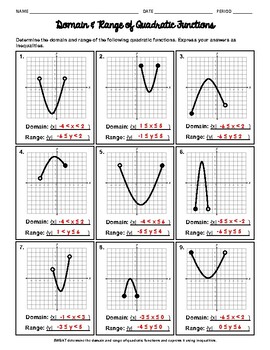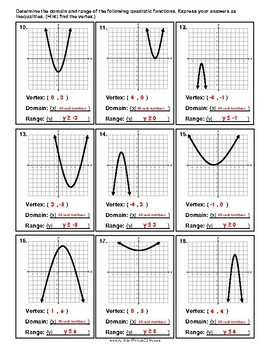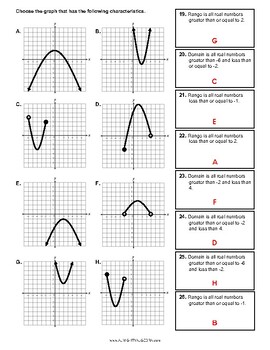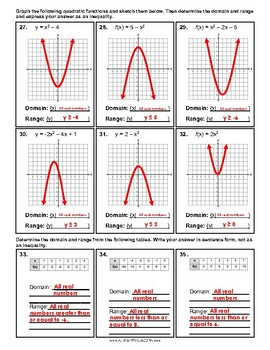Domain and Range of Quadratic Functions / Equations Worksheet
Almighty Algebra
26 Followers
Resource Type
Standards
CCSSHSF-IF.A.1
CCSSHSF-IF.B.5
Formats Included
- PDF
Pages
8 pages
Almighty Algebra
26 Followers
What educators are saying
I loved using this resource because it was quick and easy to use and it provided a great opportunity to practice the concept learned.
Description
35-question worksheet on finding the domain and range of quadratic functions:
- #1 - 9: from the graph of a parabola with two endpoints
- #10 - 18: from the graph of of a parabola with no endpoints (arrows on both ends); students are first asked to find the vertex as a hint with finding the range
- #19 - 26: choose the graph that has the given characteristics (ex: "range is all real numbers greater than or equal to 2")
- #27 - 32: sketch the graph given an equation and determine the domain and range
- #33 - 35: determine the domain and range of the quadratic functions expressed as tables; express the answer in a sentence (ex: all real numbers greater than or equal to -6)
Questions are 100% aligned to the end of year exam!
CHECK US OUT ON ALMIGHTYALGEBRA.COM FOR MORE!!
Total Pages
8 pages
Answer Key
Included
Teaching Duration
N/A
Report this resource to TPT
Reported resources will be reviewed by our team. Report this resource to let us know if this resource violates TPT’s content guidelines.
Standards
to see state-specific standards (only available in the US).
CCSSHSF-IF.A.1
Understand that a function from one set (called the domain) to another set (called the range) assigns to each element of the domain exactly one element of the range. If 𝘧 is a function and 𝘹 is an element of its domain, then 𝘧(𝘹) denotes the output of 𝘧 corresponding to the input 𝘹. The graph of 𝘧 is the graph of the equation 𝘺 = 𝘧(𝘹).
CCSSHSF-IF.B.5
Relate the domain of a function to its graph and, where applicable, to the quantitative relationship it describes. For example, if the function 𝘩(𝘯) gives the number of person-hours it takes to assemble 𝘯 engines in a factory, then the positive integers would be an appropriate domain for the function.





